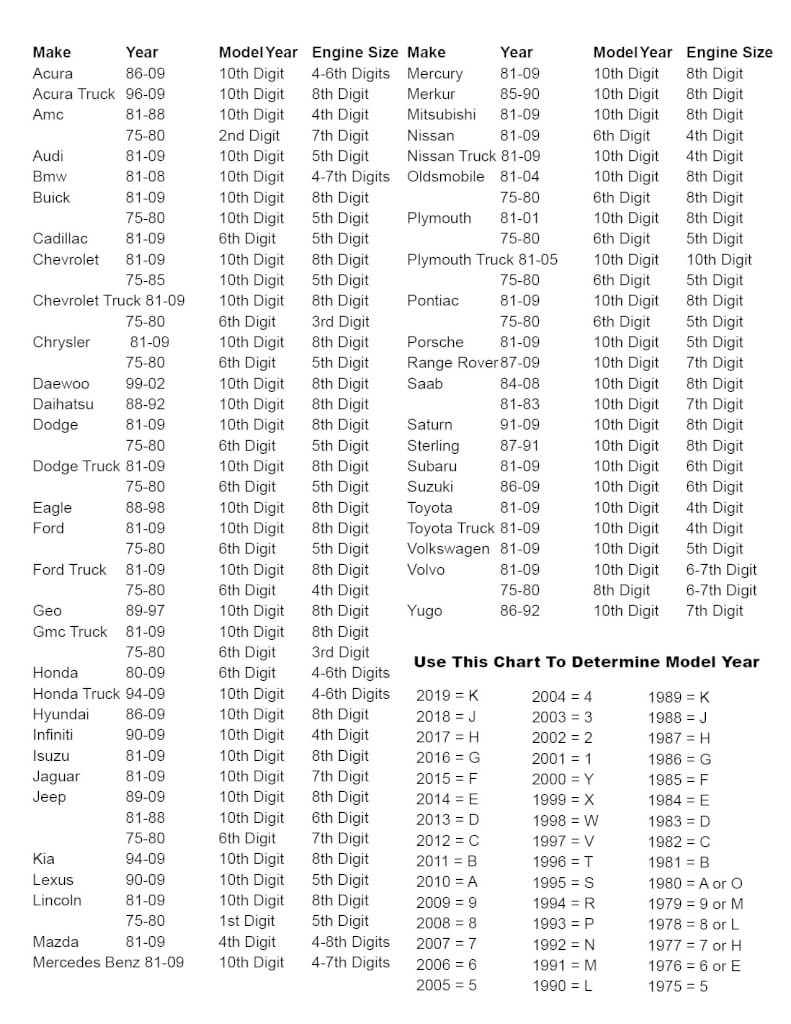VIN decoder
How to decode my VIN number
What is a VIN number?
It’s a series of numbers and letters that identify the carmaker, the engine, model year, and other important information specific to your vehicle.
Where were VIN numbers started?
In the U.S. the federal government required the American Manufacturers Association to develop a system to categorize and classify all motor vehicles in a standardized manner. Unfortunately, each automaker had its own classification system. That caused confusion. So the National Highway Traffic Safety Administration (NHTSA) required a standardized 17-digit VIN format starting in 1981. The standardization allowed a mix of numbers and letters except for the letters O, I and Q,to prevent confusion with 0, 1, and 9.
Where is the VIN located?
It’s required to be shown on the driver’s side of the dash to be viewed from outside. You’ll also find it on the vehicle’s title, its registration, and many carmakers stamp the VIN into inconspicuous places– or sometimes hidden altogether
Deciphering the VIN
The first three letters of the VIN denote the manufacturer of the vehicle – such as Toyota, Jeep or BMW for example – using what is known as the “world manufacturer identifier,” or WMI for short. That denotes where in the world it was made – or where it was assembled.
The first character refers to the region of the world where the automaker’s headquarters are located. Letters A-H are used for counties located in Africa, letters J-R for countries located in Asia, letters S-Z for European nations, numbers 1-5 for North American as well as Central American and some Caribbean countries, numbers 6-7 for Oceanic nations (Australia and New Zealand, specifically) and numbers 8 and 9 for South American countries.
The second and third characters of the VIN show the carmaker. Sometimes they’re easy to interpret. For example, “VW” identifies the vehicle like a Volkswagen. And sometimes they’re a bit more cryptic. “G1” translates to a Chevrolet car, while “GC” means it’s a Chevrolet truck.
A VIN’s fourth through ninth characters describe the vehicle’s type. Is it a passenger car? A freight truck? A horse trailer? Characters 4-9 will let you know. Also known as the “vehicle descriptor section” or VDS for short, it can include details on the specific platform, the model and the body style. Every manufacturer uses its own specific system for categorizing its vehicles with the VDS. Usually, the eighth or ninth character denotes the specific engine type when there’s more than one option available for a single car, such as the difference between a V6 and a V8.
The last string of digits in the VIN – characters 10-17 – are known as the “vehicle identifier section” or VIS for short. The last eight digits are essentially your vehicle’s serial number. A dealer can identify all the components used in your vehicle with the model year and last 8 digits of your VIN.
The current VIN system is set to last up until 2039, after which it will most likely repeat itself for another cycle, returning to “A” for 2040 model year vehicles.
Many websites offer VIN deciphering simply by entering your VIN number. But many sites use your information to try and sell you additional services, so be careful which sites you choose to decipher your VIN.
© 2015, Rick Muscoplat
Posted on by Rick Muscoplat

